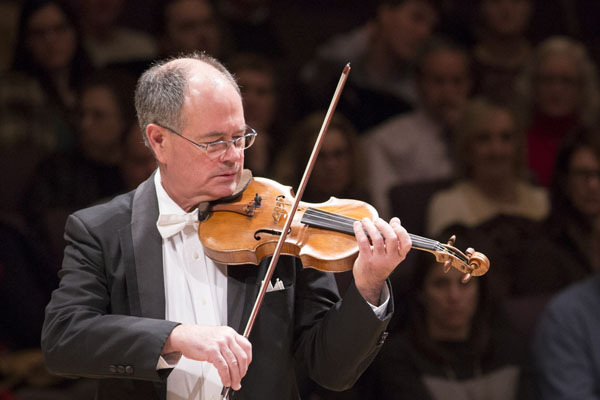The North Carolina Symphony‘s latest concert shook things up a little with new and old, welcoming guest conductor Ben Gernon and spotlighting NCS’s long-time concertmaster Brian Reagin with a Bruch Concerto (associate concertmaster Dovid Friedlander took the primary chair). With four different works on the program (with multiple movements among them), this concert featured a plethora of textures, moods, and images.
Contemporary composer Nico Muhly‘s Mixed Messages got the program off to a bold beginning, with brass and percussion clashes waging war against an undulating fury of strings. The result was a relentless wave of sound that is somehow not overwhelmingly dissonant. While this work may not have been everyone’s favorite, it can certainly be appreciated for its difficulty – the orchestra’s ability to keep everything aligned shone through here. Gernon’s sharp conducting brought each melodic line out of the fabric as it rose to importance.
This was also true with Max Bruch’s Violin Concerto No. 1, in G minor, as Gernon struck a valuable balance between rumbling and stormy textures in the orchestra without encroaching on Reagin’s urgent and ornate solo moments. The first movement of the concerto gets right to the point with solo cadenzas, leading directly into the soft, throaty, and ultra-legato Adagio movement. There were hints of sorrow here, but just for a moment; Reagin played in perfect sync with the orchestra, showing his immense experience and talent. A pause and slow buildup of tension led to the Finale, which is energico indeed. A unique texture of rapid, double-bowed solo lines over pizzicato strings occurs, making the movement playful and dancelike. The orchestra’s emphatic echo of the theme (first heard in the violin) closes the concerto, and the first half of the concert ended with a standing ovation for the orchestra and its soloist.
Lovers of Disney’s Fantasia 2000 would quickly recognize the name Pines of Rome, or at least the soaring brass and shimmering strings that trademark the work. Perhaps lesser known is composer Respighi’s companion work (actually one of three) Fountains of Rome. Each movement of the former pinpoints a specific copse of Pines in Rome (more or less), but the movements of the latter also gives each setting a specific time. The composer’s accompanying program notes, as well as the music itself, allow the listener literally to travel to a specific place and time as they listen. Of course, the NCS and Gernon seamlessly brought these scenes to life. Fountains of Rome, with its specific times of day for each movement, is captivating; one might imagine the composer himself considering how the first rays of dawn reflect on the fountain in the first movement, the “Fountain of Valle Giulia.” Here, tentative but sparkling strings underscore a beautiful clarinet melody. The swooping phrases of the second movement lead into the grand and militant “Fountain of Trevi,” a texture similar to the Pines‘ Finale.
The NC Symphony marvelously accomplished the arc of the day in Fountains; the chilling but serene low string melody was a highlight at the end. Pines of Rome was a naturally similar journey, with the first movement’s unbridled joy and the kaleidoscopic middle movements featuring the orchestra’s woodwinds as birds setting the scene. Then, the Finale: a slow, ominous-sounding buildup from below explodes into a joyful, triumphant wall of sound where the vibrations can be felt in the listener’s chest (in a good way). Naturally, this movement was a thrilling choice to end a marvelous, multi-faceted concert.
This program repeats Saturday, March 24 at Raleigh’s Meymandi Concert Hall. See our sidebar for details.













